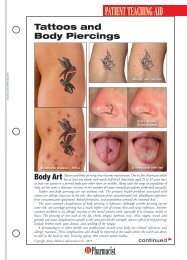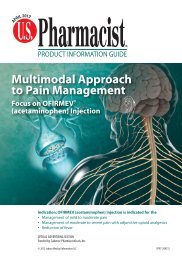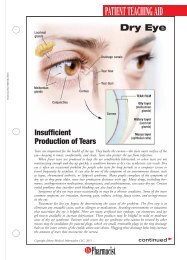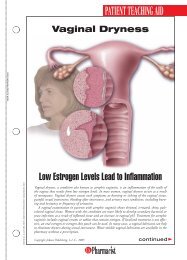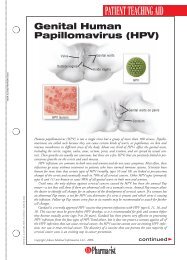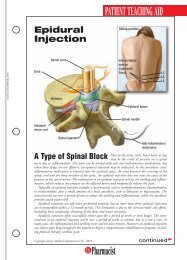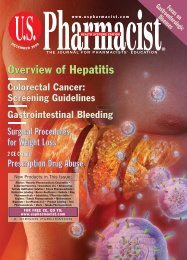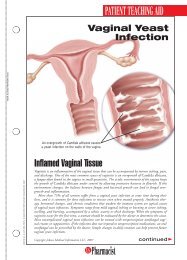View PDF Edition - U.S. Pharmacist
View PDF Edition - U.S. Pharmacist
View PDF Edition - U.S. Pharmacist
You also want an ePaper? Increase the reach of your titles
YUMPU automatically turns print PDFs into web optimized ePapers that Google loves.
Generic Trends“Free Generic Fill”Provision in HealthCare ReformLegislationApplauded by GPhA“GPhA applauds theSenate Finance Committeefor approving the‘Free Generic Fill’ provision[in health carereform legislation],which would savepatients and the federalgovernment more than$6 billion over 10years,” commentedKathleen Jaeger, presidentand CEO of theGeneric PharmaceuticalAssociation (GPhA).The “free generic fill”provision creates anexception that wouldallow health plan sponsorsto encourage beneficiariesto utilize genericdrugs by allowing themto waive copays as anincentive to try a genericdrug.“Clearly, Congress hasrecognized that expandingaccess to genericmedicines is the key tolowering health carecosts...,” said Jaeger.Innovative PharmacyBenefit PlanDesign Can OptimizeGeneric UtilizationData from research conductedby CVS Caremarkand presented at theAcademy of ManagedCare Pharmacy (AMCP)Annual Educational Conferenceshowed that innovativepharmacy benefitplan design can impactgeneric utilization. Specifically,the study foundthat implementing a $0copay structure forgeneric medications canbe an effective strategy toincrease generic dispensing,with the generic dispensingrate increasing to60.8% (which representsa 4.2% increase).“The data presented atAMCP illustrate anexample of how we canwork with our plan sponsorsto change and optimizeparticipant behaviorin order to achieveincreased generic utilization,”said Jack Bruner,executive vice president,CVS Caremark.Some other datauncovered by the studyshowed that the averageparticipant cost share forgeneric medicationsdecreased almost 10%and the average plan costper 30 days of therapyalso exhibited a slightdecline, despite thereduction in genericcopayment rates.Call for PapersU.S. <strong>Pharmacist</strong> is seeking authors to write clinical articles and continuing education lessons on a variety of topics. While we willentertain all subject matter, we are particularly interested in articles that correspond to our “Editorial Focus” therapeutic areas. Thetherapeutic categories and the months for which they are planned are listed below:Cardiovascular Diseases – FebruaryEndocrinology – JuneGastroenterologic Diseases – DecemberInfectious Diseases – AugustNeurologic Diseases – JanuaryNew Drugs – OctoberOphthalmology – AprilPain Management – MayPediatric and Adolescent Health – MarchPsychotropics – NovemberRespiratory Diseases – JulyWomen’s Health – SeptemberIn addition to these topics, we also publish supplements each yearcovering oncology and hematology, diabetes, the generic drugindustry, and OTC drugs.In the majority of cases, articles are peer-reviewed and an honorariumis offered based on their complexity and length. As a generalguideline, we would like the articles to be approximately 2,500–2,800 words, including references and tables. Continuingeducation lessons should be approximately 6,000 words, includingreferences, tables, and exam. Prospective authors are urged toreview the “Author Guidelines” on the U.S. <strong>Pharmacist</strong> Web siteat www.uspharmacist.com.Interested authors should contact Rob Davidson, Executive Editor(rdavidson@jobson.com), with the topic(s) they would like to cover.All articles must be original and exclusive to U.S. <strong>Pharmacist</strong>.




